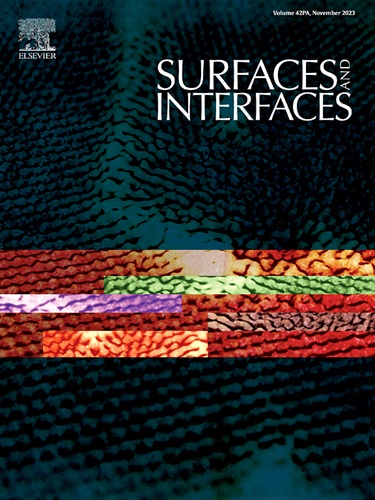A novel catalyst featuring highly stable cobalt and manganese nitride nanoclusters dispersed on single atom-anchored carbon nanotubes for hydrolytic release of hydrogen from ammonia borane
IF 5.7
2区 材料科学
Q2 CHEMISTRY, PHYSICAL
引用次数: 0
Abstract
This study investigated the long-term stability of cobalt (Co) and manganese nitride (Mn4N) nanoclusters in the catalytic hydrolysis of a promising hydrogen (H2) storage material, ammonia borane (H3NBH3; AB), to release H2. It was previously found that Co nanoparticle/Co single-atom catalysts (Co NP/Co SACs) anchored on carbon nanotubes (CNT) exhibited excellent reactivity and stability towards AB hydrolysis and high performance in the H2 evolution reaction in alkaline media. Therefore, the current study synthesised CoMn4N/Co-Mn-Nx-CNT-200–800, a CoMn-based catalyst with Co and Mn4N nanocluster active sites, and examined its performance in AB hydrolysis. CoMn4N/Co-Mn-Nx-CNT-200–800 generated three equivalents of H2 from AB within 5 min, outperforming the catalytic activity of previously reported Co NPs/Co SACs. Moreover, CoMn4N/Co-Mn-Nx-CNT-200–800 maintained over 90 % of its initial activity after 50 cycles of AB hydrolysis. This exceptional long-term stability is attributable to CoMn4N/Co-Mn-Nx-CNT-200–800 bearing Co/Mn4N nanoclusters that were strongly adhered onto graphitic layers, thereby preventing metal-atom aggregation and leakage during AB hydrolysis. Thus, CoMn4N/Co-Mn-Nx-CNT-200–800 displayed a maximum effective H2 generation rate of 8372 mLH2·gCoMn−1·min−1. These results highlight the potential of dispersed bimetallic nanocluster catalysts, such as CoMn4N-based catalysts, for practical and sustainable H2 generation via AB hydrolysis. In addition, the insights gained from this study can inform the design of highly active and stable non-precious metal-based catalysts for energy-related applications.

一种新型催化剂,具有高度稳定的钴和氮化锰纳米团簇,分散在单原子锚定的碳纳米管上,用于氨硼烷水解释放氢
本研究考察了钴(Co)和氮化锰(Mn4N)纳米团簇在催化水解有前途的氢(H2)储存材料氨硼烷(H3NBH3;AB)释放H2。研究发现,锚定在碳纳米管(CNT)上的Co纳米颗粒/Co单原子催化剂(Co NP/Co SACs)对AB水解具有良好的反应活性和稳定性,在碱性介质中表现出较高的析氢性能。因此,本研究合成了CoMn4N/Co- mn - nx - cnt -200 - 800,这是一种具有Co和Mn4N纳米簇活性位点的com基催化剂,并研究了其在AB水解中的性能。CoMn4N/Co- mn - nx - cnt -200 - 800在5分钟内从AB中生成3个当量的H2,其催化活性优于先前报道的Co NPs/Co sac。此外,经过50个AB水解循环后,CoMn4N/ Co-Mn-Nx-CNT-200-800保持了超过90%的初始活性。这种特殊的长期稳定性归因于CoMn4N/Co- mn - nx - cnt -200 - 800承载Co/Mn4N纳米团簇,这些纳米团簇被强烈粘附在石墨层上,从而防止了AB水解过程中金属原子的聚集和泄漏。因此,CoMn4N/ Co-Mn-Nx-CNT-200-800的最大有效产氢速率为8372 mLH2·gCoMn−1·min−1。这些结果突出了分散双金属纳米团簇催化剂的潜力,如comn4n基催化剂,在实际和可持续的AB水解制氢方面的潜力。此外,从本研究中获得的见解可以为高活性和稳定的非贵金属基催化剂的设计提供信息,用于能源相关应用。
本文章由计算机程序翻译,如有差异,请以英文原文为准。
求助全文
约1分钟内获得全文
求助全文
来源期刊

Surfaces and Interfaces
Chemistry-General Chemistry
CiteScore
8.50
自引率
6.50%
发文量
753
审稿时长
35 days
期刊介绍:
The aim of the journal is to provide a respectful outlet for ''sound science'' papers in all research areas on surfaces and interfaces. We define sound science papers as papers that describe new and well-executed research, but that do not necessarily provide brand new insights or are merely a description of research results.
Surfaces and Interfaces publishes research papers in all fields of surface science which may not always find the right home on first submission to our Elsevier sister journals (Applied Surface, Surface and Coatings Technology, Thin Solid Films)
 求助内容:
求助内容: 应助结果提醒方式:
应助结果提醒方式:


